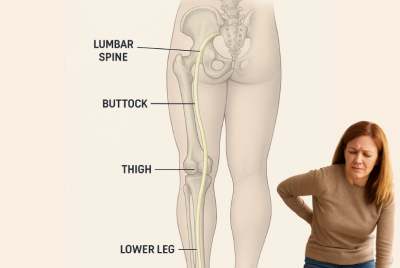Can Sciatica Be Cured
Discover how sciatica can be cured and explore effective treatments, natural remedies, and lifestyle changes for lasting relief from pain. If you’re suffering from sciatica, you’re likely searching for answers to one burning question: Can sciatica be cured? I’ve been working with individuals suffering from this painful condition for a while, and I’m here to give you an honest, straightforward answer. While sciatica can often be managed and significantly improved, achieving a “cure” isn’t as simple as you might hope. But don’t worry—I’m going to explain why and guide you through ways to relieve your pain effectively.
Understanding Sciatica
What Exactly Is Sciatica?
Sciatica refers to pain that radiates along the path of the sciatic nerve, which runs from your lower back through your hips and buttocks and down each leg. It typically affects only one side of the body, and the intensity can range from a mild ache to excruciating discomfort. Sciatica isn’t a diagnosis but rather a symptom of an underlying issue.
Causes of Sciatica
There are various causes of sciatica, and understanding these is essential for tackling the pain effectively.
Herniated Disc
One of the most common causes of sciatica is a herniated disc. This happens when one of the discs in your spine pushes out and compresses a nearby nerve, including the sciatic nerve.
Spinal Stenosis
Another frequent culprit is spinal stenosis, where the spaces within your spine narrow and put pressure on the nerves. This pressure can lead to pain, numbness, or weakness down the legs.
Piriformis Syndrome
Piriformis syndrome is less common but still a valid cause of sciatica. In this case, the piriformis muscle irritates or compresses the sciatic nerve.
Symptoms of Sciatica
Common Signs to Watch Out For
Most people with sciatica describe the pain as a sharp, shooting sensation down one leg. It can be accompanied by numbness, tingling, or muscle weakness. Some may feel a burning or stabbing pain, especially when standing up after sitting for a long time.
When Should You See a Doctor?
If your pain lasts more than a few weeks, or if it’s accompanied by significant leg weakness or bowel and bladder issues, it’s essential to seek medical attention. These could be signs of a more severe condition requiring immediate treatment.
Can Sciatica Be Cured Completely?
Temporary Relief vs. Permanent Cure
Here’s the truth—sciatica can often be managed rather than completely cured, especially if the underlying cause is chronic, such as arthritis or spinal stenosis. However, many people experience long-term relief through a combination of treatments. The goal is to reduce inflammation, alleviate pressure on the nerve, and prevent future flare-ups.
The Importance of Early Diagnosis
Early intervention can make a significant difference. If caught early, sciatica caused by a herniated disc or muscle irritation may resolve with conservative treatments like physical therapy and pain management.
How To Cure Sciatica Permanently
Natural Remedies for Sciatica Relief
Exercise and Stretching
Exercise is crucial for relieving sciatica. Simple stretches, such as the seated forward bend or knee-to-chest stretch, can alleviate pressure on the sciatic nerve. Regular movement keeps your muscles strong and flexible, reducing the likelihood of nerve irritation.
Yoga for Sciatica
Gentle yoga can work wonders. Poses like the child’s pose and the pigeon pose helps stretch the lower back and hips, providing relief from sciatic pain. It’s all about releasing tension in the right areas.
Heat and Cold Therapy
Applying heat can relax tight muscles, while cold packs reduce inflammation. A combination of both therapies may give you immediate relief, but be sure to alternate between them for the best results.
Lifestyle Changes for Long-Term Relief
Weight Management
Carrying extra weight, especially around the midsection, can put extra pressure on your spine. By maintaining a healthy weight, you relieve unnecessary stress on your lower back and improve overall spinal health.
Posture and Ergonomics
How you sit and stand plays a huge role in sciatica pain. Make sure your chair supports your lower back and that you’re sitting up straight. Ergonomically designed chairs or lumbar support cushions can make a difference.
Avoiding Prolonged Sitting
Sitting for long periods can irritate the sciatic nerve. If you have a desk job, take breaks every 30 minutes to stand up, stretch, and move around.
Medical Treatments for Sciatica
Physical Therapy
Physical therapy can target specific areas of weakness or tension. A therapist will work with you to develop a personalized plan that might include exercises, stretches, and techniques to improve mobility and reduce pain.
Pain Medications
Over-the-counter pain relievers like ibuprofen or acetaminophen can reduce inflammation and provide temporary relief. In more severe cases, prescription medications may be necessary.
Steroid Injections
For those with intense pain, corticosteroid injections can help reduce inflammation around the irritated nerve. While these injections don’t cure sciatica, they can provide significant relief for several months.
Surgery as a Last Resort
If all else fails, surgery may be an option. Procedures like a discectomy or laminectomy can help relieve pressure on the sciatic nerve. However, surgery is generally considered a last resort when conservative treatments have been exhausted.
The Role of Mental Health in Sciatica Recovery
Stress and Pain Perception
Stress can actually make your pain feel worse. When you’re anxious, your muscles tense up, which may intensify sciatica symptoms. Techniques like deep breathing, meditation, or mindfulness can help manage this.
Mind-Body Techniques for Pain Relief
Mind-body practices like tai chi, qigong, pilates, or biofeedback can reduce the intensity of sciatica by helping you focus on your body’s movements and relaxation.
FAQs Related to Can Sciatica Be Cured
How long does it take to recover from sciatica?
Recovery time varies. Mild cases may improve within weeks, but more severe cases can take several months.
Can sciatica go away on its own?
Yes, in some cases, sciatica resolves without treatment. However, addressing the underlying cause is essential for preventing recurrence.
Are there any exercises to avoid with sciatica?
Yes, avoid exercises that place extra pressure on the lower back, such as heavy lifting or high-impact activities like running.
Can sciatica return after treatment?
Unfortunately, yes. Sciatica can flare up again, especially if the underlying cause isn’t addressed or lifestyle changes aren’t maintained.
Is chiropractic care helpful for sciatica?
Chiropractic adjustments can help relieve pressure on the sciatic nerve, but it’s essential to consult with a healthcare provider to determine if it’s right for you.
When should I consider surgery for sciatica?
Surgery is considered when conservative treatments fail and symptoms significantly impair your quality of life, particularly if you have leg weakness or loss of bladder control.
Conclusion: Can Sciatica Be Cured?
In conclusion, can sciatica be cured? While sciatica may not always be permanently “cured,” especially in chronic cases, you can absolutely achieve significant relief with the right treatments and lifestyle changes. Whether through natural remedies, medical treatments, or a combination of both, many people find long-term relief and even periods of being symptom-free.
Disclaimer
This article is for informational purposes only and is not a substitute for professional medical advice, diagnosis, or treatment. Always consult with your healthcare provider before starting a new exercise or stretching routine, especially if you have existing back or nerve conditions.
👉 Explore more:





